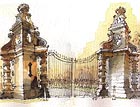Buying Entrance Gates
Entrance gates need not be barriers without any thought to design or message, says architect Ptolemy Dean


Never judge a book by its cover, or so they say. If only it could be true for entrance gates. We do judge an owner by them, and what alternative can there be if these gates unexpectedly appear across an open road or driveway? Suddenly there is a message that at its most polite might be translated as 'please go away'. Even if the gates are the result of necessary security needs or the unyielding demands of an insurance company, the design of entrance gates appear to be among the hardest of things to get right, and at their worst, can cause positive offence. It is hard to explain exactly why this should be, and although I await my first commission to design a really large set of entrance gates, I know that I would look to history for my inspiration. There are precedents that range from the most simple of farm gates to charming thatched lodges with railings attached, to those great Classical archways that are set back from the road edge with mile upon mile of estate wall on either side. No one ever seems to mind these, indeed, one delights in spotting them. Now that there are so many speed cameras on the A44 through Woodstock in Oxfordshire, one has time to really appreciate Vanbrugh and Hawksmoor's handsome gates to Blenheim Palace even if double yellow lines prevent one from parking anywhere near them. Have there ever been such robust gate piers in the history of England? They bristle with a restless Baroque energy, set at an angle to the road as if pushing themselves forward with a swanky panache. And, yet, that word that is so often in mind with modern gates is entirely absent here. No one could ever say that Blenheim was 'vulgar'. These gate piers are monuments to fine carving, light and shade, proportion and taste. Perhaps the key lies with the design of the gates themselves. The ironwork is simple and secondary to the weight and power of the piers. Therefore, the dominant impression is of the stone piers rather than the gates. Imagine these iron gates without the stone piers and something changes. The gates become tall and forbidding, an effect undiminished by the dip in the centre. The lesson is that the gates should not overwhelm the piers. Nowadays, there are companies that supply gates as a standard mass produced product. They are usually of steel and are often quite as elaborate and high as those in Blenheim. Sometimes they dip down in the middle, sometimes they rise up. But inevitably, they are attached to mean, tubular steel posts or skimpy brick piers, rather than ones of some substance. The worst examples are the modern gates which slide back on a track. Although, understandably, no one can reasonably expect to reproduce the elaborate masonry of Blenheim, it is surely important to find simpler designs where the gate and piers are more in harmony. A desire for security is under standable, but when we design entrance gates, they should be things of beauty and welcome.
- If installing entrance gates, ensure that gates are in proportion with their piers
- Avoid metal gates if an attractive and suitably reinforced timber version will suffice
- If possible, treat the design of gates as a design opportunity and avoid 'off the peg' models
Sign up for the Country Life Newsletter
Exquisite houses, the beauty of Nature, and how to get the most from your life, straight to your inbox.
Country Life is unlike any other magazine: the only glossy weekly on the newsstand and the only magazine that has been guest-edited by HRH The King not once, but twice. It is a celebration of modern rural life and all its diverse joys and pleasures — that was first published in Queen Victoria's Diamond Jubilee year. Our eclectic mixture of witty and informative content — from the most up-to-date property news and commentary and a coveted glimpse inside some of the UK's best houses and gardens, to gardening, the arts and interior design, written by experts in their field — still cannot be found in print or online, anywhere else.
-
 380 acres and 90 bedrooms on the £25m private island being sold by one of Britain's top music producers
380 acres and 90 bedrooms on the £25m private island being sold by one of Britain's top music producersStormzy, Rihanna and the Rolling Stones are just a part of the story at Osea Island, a dot on the map in the seas off Essex.
By Lotte Brundle Published
-
 'A delicious chance to step back in time and bask in the best of Britain': An insider's guide to The Season
'A delicious chance to step back in time and bask in the best of Britain': An insider's guide to The SeasonHere's how to navigate this summer's top events in style, from those who know best.
By Madeleine Silver Published
